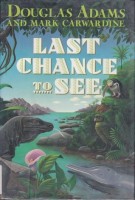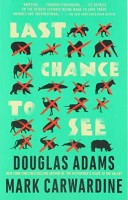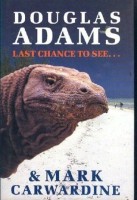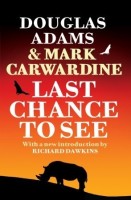 Tytuł: Last Chance to See
Tytuł: Last Chance to See
Autor(zy): Douglas Adams, Mark Carwardine
Rok wydania: 1990
Wydawnictwo: Pan Books
Dlaczego w bazie: Żółwie są wspomniane w dwóch fragmentach tej książki. Pierwszy to wzmianka o ośrodku na Mauritiusie gdzie „po podwórku” luzem chodziło sobie kilka bardzo dużych żółwi bez specjalnego nadzoru – autor wysnuwa przypuszczenie, że to dlatego, że nawet jakby spróbowały one ucieczki, właściwie każdy jest je w stanie dogonić w drodze do bramy.
Inside was a large sandy courtyard, ringed with low wooden buildings, large aviaries and cages. The warm air was rich with the sounds of flapping and cooing and sharp, bracing smells. Several very, very large tortoises were roaming about the centre of the yard completely free, presumably because virtually anybody would be able to beat them to the gate if they suddenly decided to make a break for it.
Drugi fragment także dotyczy Mauritiusa, a precyzyjniej, ptaka Dodo. Wpierw wspomniane są ogromne żółwie które masowo zajmują plażę, później zaś przytoczone jest w jaki sposób żółwie te wyginęły – zostały wybite przez marynarzy którzy zabierali je na statki w formie żywych konserw.
It didn’t need to fly anyway, since there were no predators that wished it any harm and it, in turn, is harmless itself. In fact the whole idea of harm is something it has never learnt to understand, so if you were to see one on the beach it would be quite likely to walk right up to you and take a look, provided it could find a path through the armies of giant tortoises parading round the beach. There’s never even been any reason for humans to kill it because its meat is tough and bitter.
It has a large, wide, downturned bill of yellow and green, which gives it a slightly glum and melancholic look, small, round eyes like diamonds, and three ridiculously little plumes sticking out of its tail. One of the first Englishmen to see this large dove said that 'for shape and rareness it might antagonise the Phoenix of Arabia’.
None of us will ever see this bird, though, because, sadly, the last one was clubbed to death by Dutch colonists in about The giant tortoises were eaten to extinction because the early sailors regarded them much as we regard canned food. They just picked them off the beach and put them on their ships as ballast, and then, if they felt hungry they’d go down to the hold, pull one up, kill it and eat it.





Autor: XYuriTT
